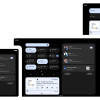State of the Industry
Enterprise
A healthy portion of the announcements at CTIA were geared toward the enterprise (business) space. There was important news on all fronts: new networks, new devices, and new services.
The biggest news was probably Verizon's 1xEV-DO plans. As I mentioned earlier, this has exciting implications for phones. But, as with Verizon's 1xRTT rollout, the initial thrust with 1xEV-DO will be with data cards for laptops.
The speed boost provided by 1xEV-DO has very important implications for corporate users. Many companies require that their road warriers use VPN software, which adds an extra level of security. But VPN software often slows down the connection to the point of being almost unusable. With 1xEV-DO, wireless VPN connections should finally be a painless, perhaps even pleasant, experience.
But true nationwide 1xEV-DO is probably still about a year off, so something else is needed in the interim. One partial solution is Wi-Fi (802.11b), and there were several Wi-Fi announcements at CTIA. Verizon Wireless announced a partnership with Wayport to offer Verizon-branded Wi-Fi service in the third quarter.
Also, T-Mobile announced an extension of its relationship with Boingo, another national wi-fi hotspot company. T-Mobile's new initiative will focus on better integration between Boingo's wi-fi network and T-Mobile's GPRS network. That is definitely the direction everyone is headed. Most of the major carriers have announced plans to eventually offer seamless coverage across wi-fi and their 2.5G and 3G wireless networks. Right now, this kind of integration is cumbersome for the user and involves complicated billing. The race is on to simplify this; the only question is who will be first.
Moving on to devices for the enterprise, there weren't many surprises, but some important devices moved closer to actual release.
Sprint PCS announced that it will carry Samsung's SPH-i700 and SPH-i500 "MITs" convergence devices. The i700 runs Microsoft's Pocket PC Phone Edition OS, and sports an integrated swivel camera. The i500 is very small Palm OS smartphone. Sprint also announced that it will offer Hitachi's G1000 device. Like the Samsung i700, it runs Pocket PC Phone Edition and features a swivel camera. It is larger and heavier, but it is also the first Pocket PC with an integrated mini-keyboard.
Verizon Wireless also announced a Pocket PC and a Palm device. Verizon will finally offer the long-awaited Kyocera 7135 Palm OS phone, and will also carry the Samsung i700. Both will be available from Verizon in April.
With their large displays and robust software platforms, these devices are ideal for enterprise applications. Another platform that some had hoped would gain traction in the enterprise space is J2ME (Java). But with their small displays and slow processors, Java-enabled phones never really seemed like a viable platform for serious business applications.
That may be about to change. With its huge display and dedicated Java processor, the NEC 515 should encourage IT managers to re-examine the idea of deploying enterprise applications for the J2ME platform. While not the smallest phone out there, the 515 still delivers portability the i700 and G1000 can't begin to touch.
What Was Missing
Perhaps more interesting than what was at the show, was what wasn't at the show. There were several key technologies and companies that were conspicuously absent this year.
First and foremost was EDGE. EDGE is an upgrade to GSM/GPRS networks that doubles or triples data speeds. AT&T Wireless, Cingular, and T-Mobile have all announced plans for EDGE. In fact, it's the "next big thing" for all three companies - the next stepping stone on the path to "3G". AT&T is planning to launch EDGE nationwide in a just a few months, and the other companies plan to follow suit by the end of the year.
With EDGE seemingly right around the corner, the complete absence of new EDGE phones was a bit of a shocker. The Nokia 6200 and 6220, Motorola T725, and a Sony Ericsson PC card for laptops have already been announced. But at this point in the game, I really expected several new EDGE phones at CTIA.
I don't think EDGE is in any jeopardy as a technology; it's a compelling upgrade for carriers. But perhaps there are technological challenges that are causing a slow start for EDGE handsets. Hopefully this will change before the end of the year.
Another technology I expected to see represented in the new phones was GAIT. GAIT is a technology designed to ease the transition from TDMA to GSM - the transition Cingular and AT&T are smack-dab in the middle of right now. GAIT phones work on both types of networks, and include special technology that allows services to operate transparently regardless of which network is being used.
AT&T Wireless has enough spectrum that they can pretty much let people switch to GSM at their leisure. Cingular, however, is not so lucky. Due to spectrum constraints, they can't start moving their network to GSM in certain areas until a certain percentage of their users in that area have GAIT phones. Really cool new GAIT phones would seem like the ideal incentive to make this happen.
Therefore, I expected some nifty new GAIT phones at CTIA. But Nokia, Siemens, and Sony Ericsson (all manufacturers of existing GAIT or GAIT-like phones) all indicated that they don't have any immediate plans for new GAIT models, although they are open to the idea if carriers request it. LG was the only company that seemed to have specific GAIT plans.
It seems that the manufacturers are simply following the demands of the carriers. If Cingular isn't asking manufacturers for new GAIT models, I'm completely stumped as to why.
Another curious absence at the show was anything to do with iDEN - the standard used by Nextel. Motorola's iDEN group had zero presence, and no new iDEN models were announced. The timing seemed about right for Motorola's rumored "Falcon" line of iDEN phones, so this was a bit surprising. Since iDEN is a relatively unpopular standard as it is, and it has been a while since Motorola came out with any new models, I would think that Motorola would be anxious to remind everyone that iDEN is still a thriving standard. Apparently this is not the case.
It has been speculated that Nextel will eventually drop iDEN and switch to CDMA. If Nextel is planning to announce such a switch soon, that could spell the end of Motorola's iDEN group. This is one possible explanation for the deafening silence from the iDEN corner, but perhaps there is a less dramatic explanation.
Another conspicuous absence was Microsoft Windows Powered Smartphone. For a very large company that is supposedly trying to make a big push into the cell phone market, Microsoft's presence was surprisingly low-key. The timing seemed right for a new Smartphone model, or at least a carrier announcement, but there was nothing of the sort. There were a few HTC Tanager (SPVx) Smartphones on display at the Microsoft booth, but no one was really talking about them. The focus seemed to be on the Pocket PC Phone Edition devices.
Microsoft did hold a co-located conference for mobility developers, which started just at CTIA ended. But that also seemed very focused on the Pocket PC platform. For example, Bill Gates announced that Microsoft is giving away 25,000 Viewsonic Pocket PCs to qualified developers, while developers still must shell out several hundred dollars for a kit that includes a Smartphone.
Particularly curious was the absence of Samsung's i600 Smartphone. As the only big-name manufacturer signed on, Samsung is key to the platform. The i600 has been previewed at several past events, and at least one version is known to be intended for U.S. CDMA networks, making its absence at CTIA all the more suspicious.
Samsung also failed to show a Microsoft Smartphone at CeBIT the week before, leading some industry observers to speculate that Samsung's Smartphone program (and relationship with Microsoft) is on the rocks. Microsoft strenuously denies that this is the case, but it's still quite puzzling.
Speaking of Samsung, their only new phone announcements at CTIA were the A600 camera phone for Sprint PCS, and the hideous Matrix phone, also for Sprint. Especially given the dizzying array of new phones announced for Europe at CeBIT the week before, their relatively anemic presence at CTIA casts doubt on the company's commitment to the U.S. market.
So that's my take on this year's show. There was some good news, some unexpected surprises, but some major disappointments as well. Most of the new phone models are evolutionary, not revolutionary, but there can't be a revolution every year. It was still a good event, and it's clear that mobile users have a lot to look forward to over the next year.


 iPhone 14 Plus Offers a Big Screen For Less
iPhone 14 Plus Offers a Big Screen For Less
 Android 12 Sports New, Customizable Look
Android 12 Sports New, Customizable Look
 Eight US States to Support Digital Driver’s Licenses in Apple Wallet
Eight US States to Support Digital Driver’s Licenses in Apple Wallet
 Google Tweaks Android Interface for Large Foldables
Google Tweaks Android Interface for Large Foldables
 Major Update to Google Messages Brings iPhone-Compatible Emoji Reactions
Major Update to Google Messages Brings iPhone-Compatible Emoji Reactions

